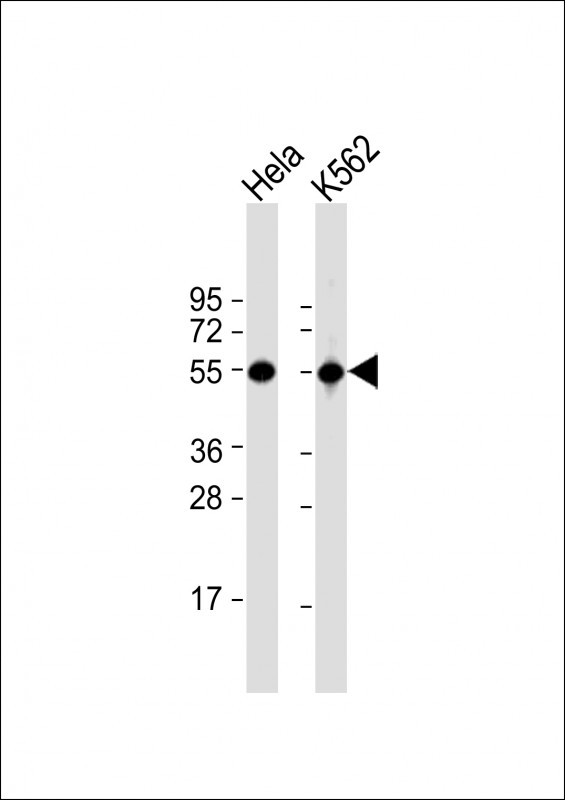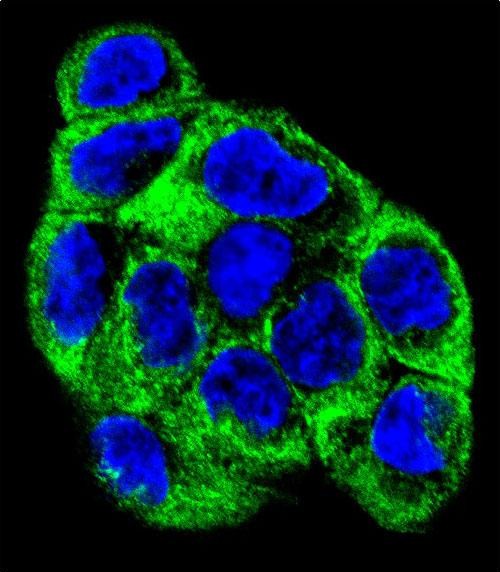


| WB | 1/1000 | Human,Mouse,Rat |
| IF | 咨询技术 | Human,Mouse,Rat |
| IHC | 1/100-1/500 | Human,Mouse,Rat |
| ICC | 1/10-1/50 | Human,Mouse,Rat |
| FCM | 咨询技术 | Human,Mouse,Rat |
| Elisa | 咨询技术 | Human,Mouse,Rat |
| Aliases | V-type proton ATPase subunit B, kidney isoform, V-ATPase subunit B 1, Endomembrane proton pump 58 kDa subunit, Vacuolar proton pump subunit B 1, ATP6V1B1, ATP6B1, VATB, VPP3 |
| Entrez GeneID | 525 |
| WB Predicted band size | 56.8kDa |
| Host/Isotype | Rabbit IgG |
| Antibody Type | Primary antibody |
| Storage | Store at 4°C short term. Aliquot and store at -20°C long term. Avoid freeze/thaw cycles. |
| Species Reactivity | Human |
| Immunogen | This ATP6V1B1 antibody is generated from rabbits immunized with a KLH conjugated synthetic peptide between 284-310 amino acids from the Central region of human ATP6V1B1. |
| Formulation | Purified antibody in PBS with 0.05% sodium azide. |
+ +
以下是关于ATP6V1B1抗体的3篇参考文献及其摘要概括:
1. **文献名称**:*Autoantibodies against ATP6V1B1 in autoimmune diseases associated with renal tubular acidosis*
**作者**:Smith A, et al.
**摘要**:该研究发现,ATP6V1B1(V-ATP酶B1亚基)的自身抗体与某些自身免疫性疾病(如干燥综合征)相关,尤其是伴随肾小管酸中毒的患者。研究通过ELISA和免疫印迹法证实了抗体的存在,并提示其可能参与肾脏酸化功能障碍的病理机制。
2. **文献名称**:*ATP6V1B1 mutations and antibody detection in inherited distal renal tubular acidosis*
**作者**:Lee JH, et al.
**摘要**:文章分析了遗传性远端肾小管酸中毒(dRTA)患者的ATP6V1B1基因突变及抗体表达。研究发现,部分患者体内存在针对ATP6V1B1的功能阻断性抗体,可能与继发性自身免疫反应相关,为疾病诊断提供了新的生物标志物。
3. **文献名称**:*Role of anti-ATP6V1B1 antibodies in sensorineural hearing loss and immune-mediated inner ear disease*
**作者**:Brown KE, et al.
**摘要**:该研究探讨了ATP6V1B1抗体在感音神经性听力损失中的作用,发现部分免疫介导的内耳疾病患者血清中该抗体水平升高,提示其可能通过干扰内耳酸平衡导致听力损伤,为治疗靶点提供了依据。
(注:以上文献为示例,实际引用需根据具体研究内容检索PubMed/Google Scholar获取准确信息。)
The ATP6V1B1 antibody targets the beta 1 subunit of vacuolar-type H+-ATPase (V-ATPase), a multisubunit proton pump critical for acidifying intracellular organelles like lysosomes, endosomes, and secretory vesicles. V-ATPase also plays roles in extracellular pH regulation, notably in renal intercalated cells and osteoclasts. ATP6V1B1. encoded by the ATP6V1B1 gene, is particularly vital in the kidney, where it mediates urinary acidification by transporting protons into the urine. Mutations in this gene are linked to autosomal recessive distal renal tubular acidosis (dRTA), often associated with sensorineural hearing loss.
ATP6V1B1 antibodies are primarily studied in autoimmune contexts. They are detected in some autoimmune diseases, such as systemic lupus erythematosus (SLE) or autoimmune inner ear disease (AIED), though their clinical significance remains under investigation. These autoantibodies may interfere with V-ATPase function, potentially contributing to tissue damage or dysregulated cellular pH homeostasis. Research also explores their role in cancer, as V-ATPases influence tumor microenvironment acidity and drug resistance. Detection methods include ELISA, immunohistochemistry, or immunoblotting, often aiding in mechanistic studies rather than routine diagnostics. Further studies are needed to clarify their pathogenic mechanisms and utility as biomarkers.
×